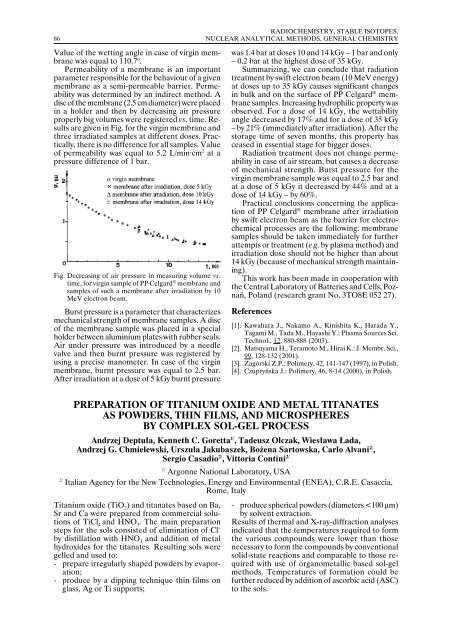annual report annual report annual report annual report 2005
annual report annual report annual report annual report 2005
annual report annual report annual report annual report 2005
Create successful ePaper yourself
Turn your PDF publications into a flip-book with our unique Google optimized e-Paper software.
86<br />
RADIOCHEMISTRY, STABLE ISOTOPES,<br />
NUCLEAR ANALYTICAL METHODS, GENERAL CHEMISTRY<br />
Value of the wetting angle in case of virgin membrane<br />
was equal to 110.7 o .<br />
Permeability of a membrane is an important<br />
parameter responsible for the behaviour of a given<br />
membrane as a semi-permeable barrier. Permeability<br />
was determined by an indirect method. A<br />
disc of the membrane (2.5 cm diameter) were placed<br />
in a holder and then by decreasing air pressure<br />
properly big volumes were registered vs. time. Results<br />
are given in Fig. for the virgin membrane and<br />
three irradiated samples at different doses. Practically,<br />
there is no difference for all samples. Value<br />
of permeability was equal to 5.2 L/min·cm 2 at a<br />
pressure difference of 1 bar.<br />
Fig. Decreasing of air pressure in measuring volume vs.<br />
time, for virgin sample of PP Celgard ® membrane and<br />
samples of such a membrane after irradiation by 10<br />
MeV electron beam.<br />
Burst pressure is a parameter that characterizes<br />
mechanical strength of membrane samples. A disc<br />
of the membrane sample was placed in a special<br />
holder between aluminium plates with rubber seals.<br />
Air under pressure was introduced by a needle<br />
valve and then burnt pressure was registered by<br />
using a precise manometer. In case of the virgin<br />
membrane, burnt pressure was equal to 2.5 bar.<br />
After irradiation at a dose of 5 kGy burnt pressure<br />
was 1.4 bar at doses 10 and 14 kGy – 1 bar and only<br />
– 0.2 bar at the highest dose of 35 kGy.<br />
Summarizing, we can conclude that radiation<br />
treatment by swift electron beam (10 MeV energy)<br />
at doses up to 35 kGy causes significant changes<br />
in bulk and on the surface of PP Celgard ® membrane<br />
samples. Increasing hydrophilic property was<br />
observed. For a dose of 14 kGy, the wettability<br />
angle decreased by 17% and for a dose of 35 kGy<br />
– by 21% (immediately after irradiation). After the<br />
storage time of seven months, this property has<br />
ceased in essential stage for bigger doses.<br />
Radiation treatment does not change permeability<br />
in case of air stream, but causes a decrease<br />
of mechanical strength. Burst pressure for the<br />
virgin membrane sample was equal to 2.5 bar and<br />
at a dose of 5 kGy it decreased by 44% and at a<br />
dose of 14 kGy – by 60%.<br />
Practical conclusions concerning the application<br />
of PP Celgard ® membrane after irradiation<br />
by swift electron beam as the barrier for electrochemical<br />
processes are the following: membrane<br />
samples should be taken immediately for further<br />
attempts or treatment (e.g. by plasma method) and<br />
irradiation dose should not be higher than about<br />
14 kGy (because of mechanical strength maintaining).<br />
This work has been made in cooperation with<br />
the Central Laboratory of Batteries and Cells, Poznań,<br />
Poland (research grant No. 3TO8E 052 27).<br />
References<br />
[1]. Kawahara J., Nakamo A., Kinishita K., Harada Y.,<br />
Tagami M., Tada M., Hayashi Y.: Plasma Sources Sci.<br />
Technol., 12, 880-888 (2003).<br />
[2]. Matsuyama H., Teramoto M., Hirai K.: J. Membr. Sci.,<br />
99, 128-132 (2001).<br />
[3]. Zagórski Z.P.: Polimery, 42, 141-147 (1997), in Polish.<br />
[4]. Czupryńska J.: Polimery, 46, 8-14 (2000), in Polish.<br />
PREPARATION OF TITANIUM OXIDE AND METAL TITANATES<br />
AS POWDERS, THIN FILMS, AND MICROSPHERES<br />
BY COMPLEX SOL-GEL PROCESS<br />
Andrzej Deptuła, Kenneth C. Goretta 1/ , Tadeusz Olczak, Wiesława Łada,<br />
Andrzej G. Chmielewski, Urszula Jakubaszek, Bożena Sartowska, Carlo Alvani 2/ ,<br />
Sergio Casadio 2/ , Vittoria Contini 2/<br />
1/<br />
Argonne National Laboratory, USA<br />
2/<br />
Italian Agency for the New Technologies, Energy and Environmental (ENEA), C.R.E. Casaccia,<br />
Rome, Italy<br />
Titanium oxide (TiO 2 ) and titanates based on Ba,<br />
Sr and Ca were prepared from commercial solutions<br />
of TiCl 4<br />
and HNO 3<br />
. The main preparation<br />
steps for the sols consisted of elimination of Cl –<br />
by distillation with HNO 3 and addition of metal<br />
hydroxides for the titanates. Resulting sols were<br />
gelled and used to:<br />
- prepare irregularly shaped powders by evaporation;<br />
- produce by a dipping technique thin films on<br />
glass, Ag or Ti supports;<br />
- produce spherical powders (diameters
















